Connecting with AudioCodes TP-260
The TrunkPack® (TP)-260/SIP is a PCI VoIP communication gateway board from AudioCodes. You can configure this device to work with Brekeke PBX to leverage your broadband phone service connections by automatically routing local calls from cell phone and land line to VoIP service provider and vice versa. This document will explain how to set up the Automatic Route Selection (ARS) for the TP-260/SIP. For more information on this product, please go to http://www.audiocode.com
TP-260/SIP Hardware Installation
The TP-260 User’s Manual describes the installation and use of this unit. It can be found in the CD (“TrunkPack Digital Boards & VoP GW Series”) that shipped with the unit.
Using a Web Browser to Enable Service
The TP-260/SIP has an embedded web server which allows you to easily view and manage your gateway’s settings through a web browser. Please follow the instructions below carefully.
- Run a web browser application on the same network that the TP-260/SIP is connected.
- Log in to the setup menu by typing: http://device’s IP address.
The following is a guide for configuring the TP-260/SIP to work with Brekeke PBX to allow you to send and receive VoIP calls. Please note that only required parameters, within Brekeke PBX and SIP server domain, are discussed here. Most of them are self explanatory and there is no need to describe them all in details. You can always consult the User’s Manual of this product if you need in-depth technical information.
The document in this section is written based on “Mediant & TP Series SIP User’s Manual” by AudioCodes, version 4.6, Document#: LTRT-68803
A quick glance on the main menu bar, you will see 7 menus as shown below.
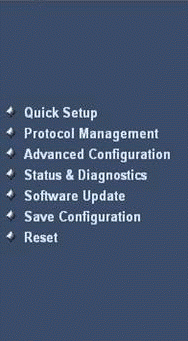
1. Quick Setup
Set up IP, SIP parameters, coder name, routing and trunk group tables.
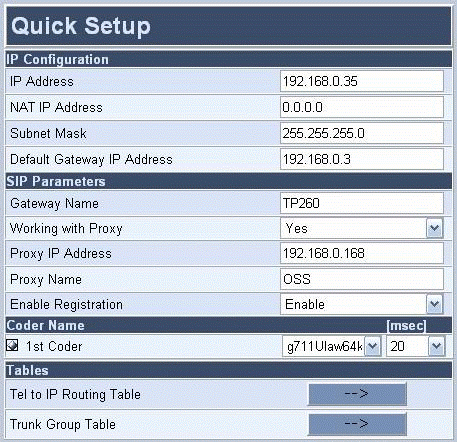
2.Protocol Management – Protocol Definition – General Parameters
Configure the gateway’s general parameters
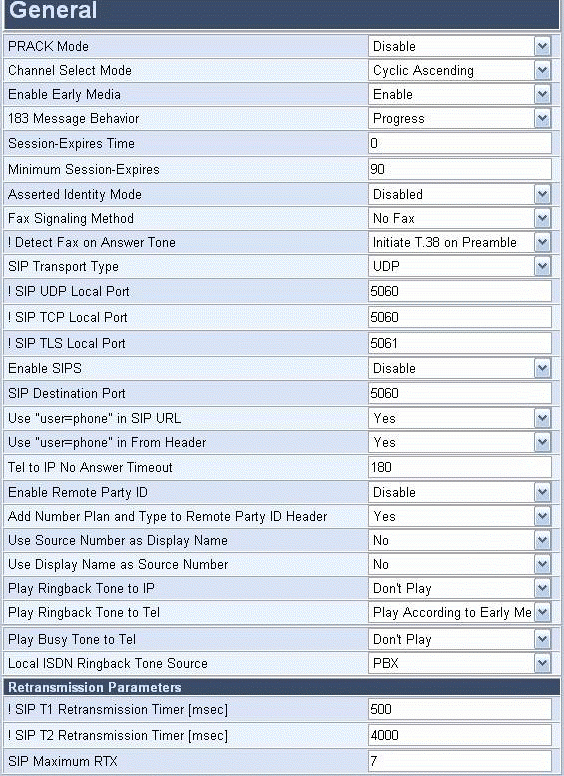
3. Protocol Management – Protocol Definition – Proxy & Registration
Configure the gateway’s proxy and registration parameters

4. Protocol Management – Protocol Definition – Coder
The current version of Brekeke PBX supports three codecs: g711Ulaw64k, g711Alaw64k and iLBC. The g711Ulaw64k codec is the most commonly used.

5. Protocol Management – Protocol Definition – DTMF & Dialing
Configure DTMF and dialing parameters

6. Protocol Management – Routing Tables – General Parameters
Configure general parameters for routing tables
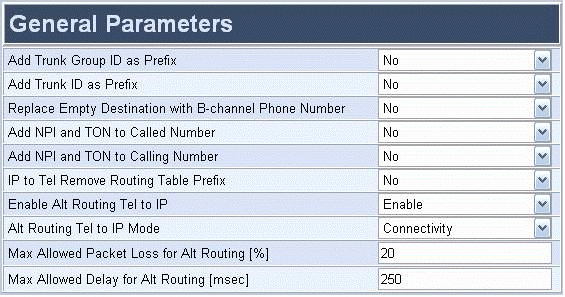
7. Protocol Management – Routing Tables – Tel to IP Routing
Configure the gateway’s Tel -> IP routing tables. It’s used to route incoming telephone calls to IP addresses when proxy server is not used.

8. Protocol Management – Routing Tables – IP to Trunk Group Routing Table
This table is used to route incoming IP calls to trunk groups based on any combination of the destination phone prefix, source phone prefix and source IP address.
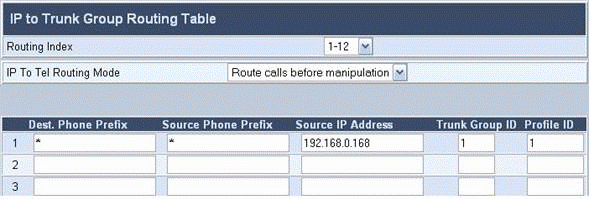
9. Protocol Management – Profile Definitions – Tel Profile Settings
You can define up to four different Tel Profiles. The gateway’s B-channel characteristic is defined based on each Tel Profile.
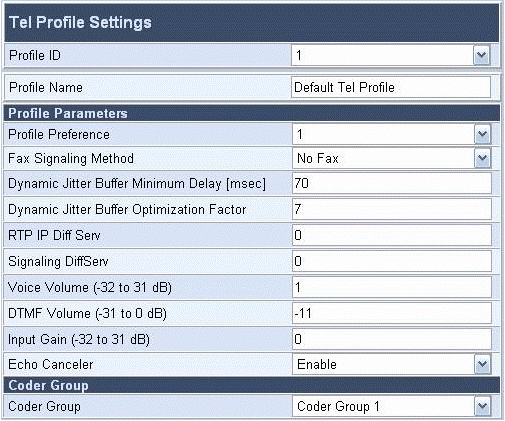
10. Protocol Management – Profile Definitions – IP Profile Settings
You can define up to four different IP Profiles. They are used in the Tel to IP and IP to Trunk Group Routing tables to associate different profiles to routing rules.

11. Protocol Management – Trunk Group
Use this table to assign trunk groups, profiles and logical telephone numbers to the gateway’s E1/T1 B-channels.

12. Protocol Management – Trunk Group Settings
This table is used to determine the method in which new calls are assigned to B-channels within each trunk group.
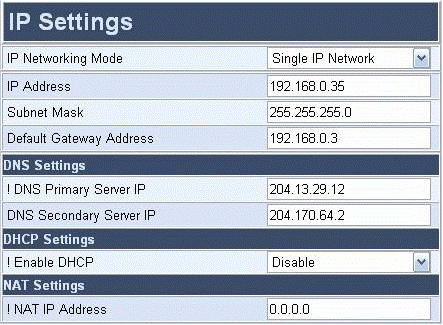
13. Advanced Configuration – Network Settings – IP Settings

14. Advanced Configuration – Channel Settings – Voice Settings
These menus allow you to set up the gateway’s channel parameters for voice, fax, RTP and IPmedia.
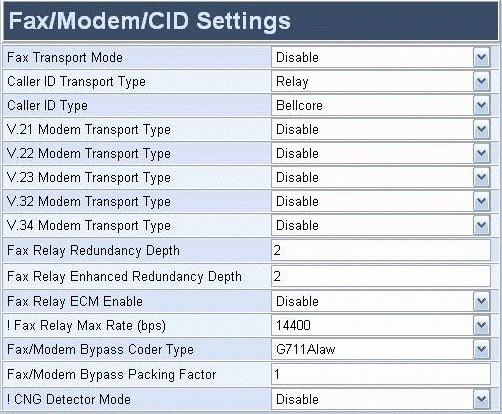
15. Advanced Configuration – Trunk Settings
This menu allows you to configure the parameters of a specific trunk. It’s very important that you set the T1 parameters in this menu to match with the settings of T1/E1 trunk.
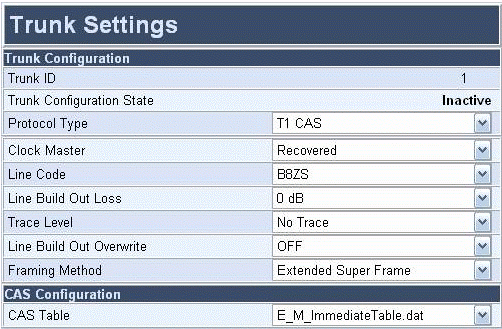
After applying trunk settings, you should see the trunk status like this which indicates no alarm on trunk 1.

If you have encountered other alarm(s), please refer to the trunk status color indicator below to diagnose the problem before proceeding to the next section.
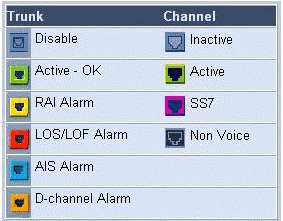
Dial Plan or ARS Setting
For Brekeke SIP Server Users, please check wiki post Connecting Gateways with BSS
For Brekeke PBX users, please check wiki post Connecting Gateways with BPBX or Update Issues from v2.2.7.7 and before
Sample ARS Pattern-OUT for outbound calls at [Brekeke PBX Admintool]>[ARS]>[New Route]
Pattern – OUT
----------------------- Matching Patterns: To=sip:([0-9]{7,25})@ Deploy Patterns: To=sip:$1@gateway_IP ------------------------
Making Test Calls
At this point, you are ready to make the test calls to ensure the T1/E1 trunk; TP-260/SIP and Brekeke PBX are in sync and working seamlessly.
- Incoming calls: Call the telephone numbers of your T1/E1 voice circuit from your mobile or landline phone and make sure calls are connected to Brekeke PBX.
- Outgoing Calls: Dial destination number from one of the extension of Brekeke PBX and make sure calls are connected to the destination number.
